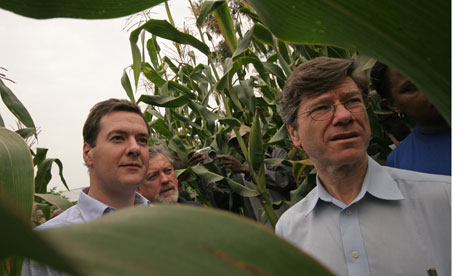The project is not throwing 'gazillions' of dollars at poverty, and evaluation is based on rigorous measurement, detailed comparisons with other sites, and peer-reviewed science

UK chancellor George Osborne and Jeffrey Sachs inspect maize crops in Ruhiira, Uganda, which is part of the Millennium Villages Project. Photograph: Stuart Price/AFP
The Millennium Villages Project (MVP) is a systematic approach to achieving the millennium development goals in rural Africa. The model is community-led development with simultaneous, integrated, science-based interventions in five main areas: agriculture, education, health, infrastructure (roads, power, water, sanitation, connectivity), and business development. The project's bottom line is to achieve the MDGs in the millennium village sites in ways that are rigorously documented, replicable and scalable.
When we began the project, we knew that randomised trials would not be the appropriate methodology for evaluating it's impact. Our focus was, and is, on designing operational systems across many sectors to achieve the eight MDGs, a task that is far more complex than can be addressed in a standard clinical trial. Systems design in a complex setting is based on local context, learning by doing, community participation, and a high degree of technical innovation – especially using information and communication technology tools. Designing such systems is quite different from testing a new drug or a new bednet, neither of which is the point of the project or its main contribution to achieving the MDGs.
Of course, the MVP is based on rigorous measurement, detailed comparison of the villages with other sites, and peer-reviewed science. It is just not framed as a simple randomised trial among a few "arms" of an experiment. Rather, we document the methods of advancing the MDGs, measure budgetary needs with care, and create a portfolio of online tools for replicability and scalability of the successes. The approach is enormously successful. The millennium villages are making rapid progress towards the MDGs, much faster than in the countries at large, and in a manner that is leading to massive imitation, replication and scaling.
An approach like this is rigorous and adaptive. Course corrections are informed by real-time information on working models – for example, on the design and management of community-based health systems. The questions that the project and the communities have together identified and addressed are about human resources, systems management, information flows, community participation and empowerment, and, of course, results. Our methods are quantitative and peer-reviewed (you can find a full list of scientific publications stemming from the MVP here).
There are very few studies like ours that take as their end point the success of the MDGs in real time and with carefully monitored budgets. That's the bottom line that should be of interest to readers of the Guardian. The questions we hope the informed reader would want to hear answered are: what are the key pathways of progress towards the MDGs, how much do they cost, and how can they be replicated and scaled up?
The inputs and outputs of the project are all carefully measured. The budgetary costs are studied. Contrary to the loose talk of critics, this project is not throwing "gazillions" of dollars at poverty. The project spent $60 on each villager every year between 2006 and 2011 to build the capital of the community. That prompted further contributions from the government itself and in-kind contributions from the community. This is a replicable and scalable budget model, well within the official development assistance amounts donors have long promised. It's nonsense to suggest otherwise, or to change the game now this amount has been shown to work so powerfully.
The systems the Millennium Villages Project are building and working to expand will continue to be improved and upgraded along the way, and we will follow the challenges and successes of our colleagues in the villages for much longer. Our critics are quick to point out how we should be doing this or that better, but they do not offer concrete alternative models for achieving the MDGs. We wish they would. When improved methods of service delivery come along, the project is very keen to take on those lessons and ideas.
We are eager to join forces with others working practically, holistically and successfully to achieve the goals. We are developing new tools, notably tools based on new information and communications technologies, while harnessing cutting-edge advances in agriculture, health and infrastructure systems (for instance, solar power).
We want to hear from others in the same line of activity. If you have interesting and promising results, please get in touch by emailing: mvp@ei.columbia.edu.

